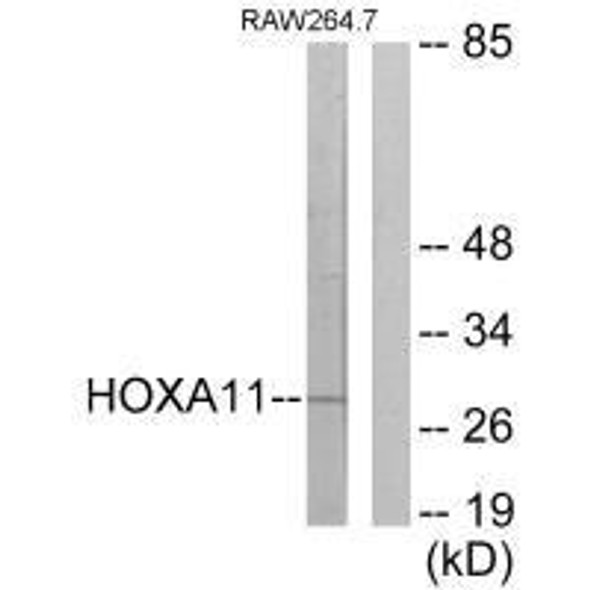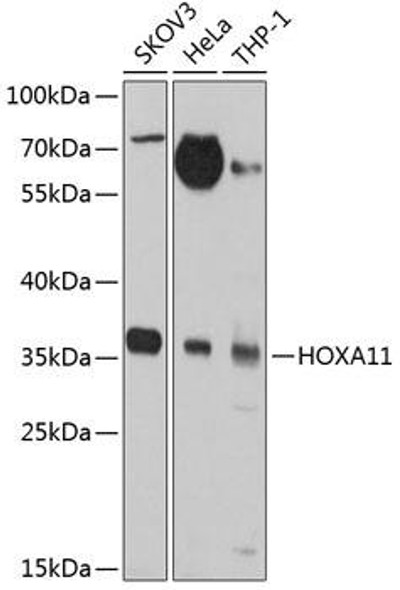Description
HOXA11/HOXD11 Antibody (PACO06560)
The HOXA11/HOXD11 Antibody (PACO06560) is a polyclonal antibody designed for research involving the HOXA11 and HOXD11 proteins, both of which are members of the HOX gene family. These proteins play critical roles in embryonic development and differentiation, particularly in the formation of the skeletal system and organs.This antibody, raised in rabbits, is highly specific and reactive with human samples, making it ideal for use in various applications such as immunohistochemistry and Western blotting. It specifically binds to the HOXA11 and HOXD11 proteins, enabling precise detection and analysis in different cell types and tissues.
Research on HOXA11 and HOXD11 is essential for understanding their functions in development and disease. Dysregulation of these proteins has been linked to various congenital anomalies and cancers, making them potential targets for therapeutic interventions. By studying the expression and activity of HOXA11 and HOXD11 using this antibody, researchers can gain valuable insights into their roles in health and disease.
| Antibody Name: | HOXA11/HOXD11 Antibody (PACO06560) |
| Antibody SKU: | PACO06560 |
| Size: | 50ug |
| Host Species: | Rabbit |
| Tested Applications: | ELISA, WB, IHC, IF |
| Recommended Dilutions: | ELISA:1:20000, WB:1:500-1:2000, IHC:1:100-1:300, IF:1:200-1:1000 |
| Species Reactivity: | Human, Mouse |
| Immunogen: | Synthesized peptide derived from the C-terminal region of human HoxA11/D11. |
| Form: | Liquid |
| Storage Buffer: | Liquid in PBS containing 50% glycerol, 0.5% BSA and 0.02% sodium azide. |
| Purification Method: | The antibody was affinity-purified from rabbit antiserum by affinity-chromatography using epitope-specific immunogen. |
| Clonality: | Polyclonal |
| Isotype: | IgG |
| Conjugate: | Non-conjugated |
 | Western Blot analysis of LOVO cells using HoxA11/D11 Polyclonal Antibody. |
 | Western Blot analysis of 293T-UV cells using HoxA11/D11 Polyclonal Antibody. |
| Synonyms: | HOXA11; HOX1I; Homeobox protein Hox-A11; Homeobox protein Hox-1I; HOXD11; HOX4F; Homeobox protein Hox-D11; Homeobox protein Hox-4F |
| UniProt Protein Function: | HOXA11: Sequence-specific transcription factor which is part of a developmental regulatory system that provides cells with specific positional identities on the anterior-posterior axis. Defects in HOXA11 are the cause of radioulnar synostosis with amegakaryocytic thrombocytopenia (RSAT). The syndrome consists of an unusual association of bone marrow failure and skeletal defects. Patients have the same skeletal defects, the proximal fusion of the radius and ulna, resulting in extremely limited pronation and supination of the forearm. Some patients have also symptomatic thrombocytopenia, with bruising and bleeding problems since birth, necessitating correction by bone marrow or umbilical-cord stem-cell transplantation. Belongs to the Abd-B homeobox family. |
| UniProt Protein Details: | Protein type:Transcription factor; DNA-binding Chromosomal Location of Human Ortholog: 7p15.2 Cellular Component: transcription factor complex; protein complex; nucleus Molecular Function:sequence-specific DNA binding Biological Process: embryonic forelimb morphogenesis; developmental growth; anatomical structure morphogenesis; transcription, DNA-dependent; multicellular organismal development; positive regulation of transcription, DNA-dependent; male gonad development; uterus development; anterior/posterior pattern formation; positive regulation of chondrocyte differentiation; dorsal/ventral pattern formation; ureteric bud branching; single fertilization; induction of an organ; mesodermal cell fate specification; spermatogenesis; embryonic digit morphogenesis; skeletal development; metanephros development; proximal/distal pattern formation; embryonic limb morphogenesis Disease: Radioulnar Synostosis With Amegakaryocytic Thrombocytopenia |
| NCBI Summary: | In vertebrates, the genes encoding the class of transcription factors called homeobox genes are found in clusters named A, B, C, and D on four separate chromosomes. Expression of these proteins is spatially and temporally regulated during embryonic development. This gene is part of the A cluster on chromosome 7 and encodes a DNA-binding transcription factor which may regulate gene expression, morphogenesis, and differentiation. This gene is involved in the regulation of uterine development and is required for female fertility. Mutations in this gene can cause radio-ulnar synostosis with amegakaryocytic thrombocytopenia. [provided by RefSeq, Jul 2008] |
| UniProt Code: | P31270 |
| NCBI GenInfo Identifier: | 13124744 |
| NCBI Gene ID: | 3207 |
| NCBI Accession: | P31270.2 |
| UniProt Related Accession: | P31270 |
| Molecular Weight: | |
| NCBI Full Name: | Homeobox protein Hox-A11 |
| NCBI Synonym Full Names: | homeobox A11 |
| NCBI Official Symbol: | HOXA11 |
| NCBI Official Synonym Symbols: | HOX1; HOX1I; RUSAT1 |
| NCBI Protein Information: | homeobox protein Hox-A11 |
| UniProt Protein Name: | Homeobox protein Hox-A11 |
| UniProt Synonym Protein Names: | Homeobox protein Hox-1I |
| UniProt Gene Name: | HOXA11 |
| UniProt Entry Name: | HXA11_HUMAN |














